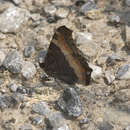Conservation Status
fornecido por University of Alberta Museums
Not of concern.
- licença
- cc-by-nc
- direitos autorais
- University of Alberta Museums
Cyclicity
fornecido por University of Alberta Museums
One, or possibly two generations per year, usually found in early spring and again in late summer.
- licença
- cc-by-nc
- direitos autorais
- University of Alberta Museums
Distribution
fornecido por University of Alberta Museums
Alaska south to California and New Mexico, east to New England and Newfoundland (Layberry et al. 1998, Opler 1999).
- licença
- cc-by-nc
- direitos autorais
- University of Alberta Museums
General Description
fornecido por University of Alberta Museums
The solid black wing bases edged with bright yellow and orange are unmistakable. Our populations are the nominate subspecies.
Recent work by Nylin et al. (2001) shows that Milbert's Tortoiseshell is more appropriately placed in the genus Aglais.
- licença
- cc-by-nc
- direitos autorais
- University of Alberta Museums
Habitat
fornecido por University of Alberta Museums
Found in many habitats, from prairie coulees to boreal forests and mountain tops.
- licença
- cc-by-nc
- direitos autorais
- University of Alberta Museums
Life Cycle
fornecido por University of Alberta Museums
The conical eggs are green with eight or nine vertical ridges (Guppy & Shepard 2001). Small larvae live communally in silken nests on the hostplant. Mature larvae are solitary, and are black with yellowish subdorsal lines, finely dotted with white, and bear branched spines (Layberry et al. 1998). This tortoiseshell is encountered much more regularly than other tortoiseshells in Alberta, apparently since it does not experience the large fluctuations in number that occur in the California and Compton Tortoiseshells. Adults are strong, rapid fliers but are easily approached when nectaring at flowers. Milbert's, like its other close relatives, overwinters as an adult, emerging early in the spring with faded and often tattered wings. The offspring of the hibernators appear from July onward. Bird et al (1995) state that there are two generations annually, but this needs confirmation; multiple generations in Canada are known only from southeastern Ontario (Layberry et al. 1998).
- licença
- cc-by-nc
- direitos autorais
- University of Alberta Museums
Trophic Strategy
fornecido por University of Alberta Museums
The larvae feed on stinging nettle (Urtica dioica) in British Columbia (Guppy & Shepard 2001) and in Alberta (D. Lawrie, unpubl. data). Unlike other members of the 'hibernator' group, adults of this species are avid flower visitors, but will also visit tree sap or rotting fruit.
- licença
- cc-by-nc
- direitos autorais
- University of Alberta Museums

